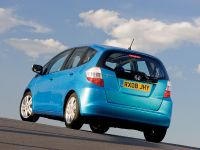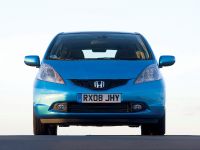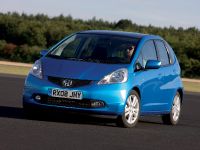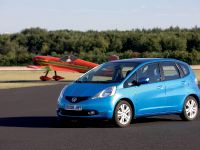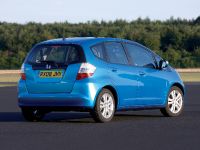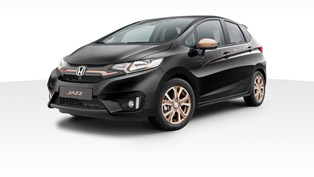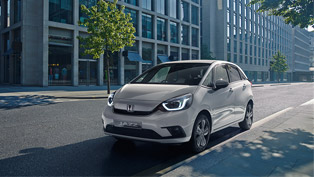The New Honda Jazz
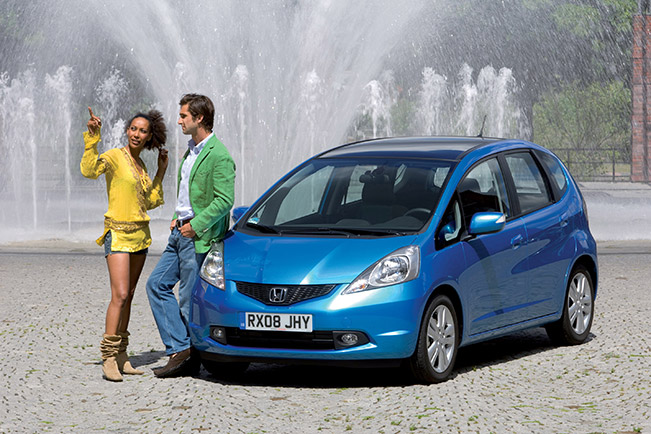 Honda's Jazz builds on the key attributes of its hugely popular predecessor with even more interior space, better functionality and more powerful, more frugal engines, in a stylish, contemporary design.
Honda's Jazz builds on the key attributes of its hugely popular predecessor with even more interior space, better functionality and more powerful, more frugal engines, in a stylish, contemporary design.
The exterior design is at first glance an evolution rather than a revolution, but this subtle change of appearance is only one small part of the thousands of changes that push the Jazz forward. It retains the concepts of the previous Jazz with its centre fuel tank layout and Magic Seats which gave it world beating interior flexibility. Yet while the best features are retained, including cabin space to rival mid-sized saloons, Jazz brings change to every area, raising the bar even further and promising to expand on its success in the supermini segment where sales have exceeded over two million around the world since its 2001 launch.
A slightly larger, ‘cab forward' style body brings better visibility and means Jazz is even more spacious, benefiting rear legroom and boot space in particular. The Magic Seats now dive down in one easy action and their versatility is now complemented by a Double-Trunk boot feature in the luggage bay.
There are greater levels of safety equipment including the introduction of Honda's Advanced Compatibility Engineering (ACE) body structure, active front seat head restraints and VSA. Larger wheels, revised suspension and a longer wheelbase/wider track bring greater agility while enhancing ride comfort.
And 90 PS 1.2-litre and 100 PS 1.4-litre i-VTEC engines deliver better performance characteristics while boosting economy to exceptional levels. There's also now the option of a 6-speed automated manual transmission on the 1.4-litre engine - a first in this class.
Greater economy and lower emission from two engines
More powerful petrol engines, capable of outstanding economy, are designed to appeal to customers who might be downsizing as well as those looking to achieve fuel economy comparable to diesel powered models. Their balance between economy and fun-to-drive performance are unmatched in the class. Adopting Honda's VTEC variable valve timing technology, the 1.2 and 1.4-litre four-cylinder engines are connected to either a 5-speed manual transmission or, on 1.4 models, Honda's i-SHIFT 6-speed automated manual transmission which includes steering wheel-mounted paddle shifters.
Both engines deliver lively performance and plentiful torque across all engine speeds.
SIL (Shift Indicator Light) fitted to manual models, similar to that found on the Accord, provides a visual prompt of the best gear shift points to maximise economy.
Cab forward styling and increased dimensions
At 3900 mm long, 1695 mm wide and 1525 mm tall, the Jazz occupies its own unique niche between superminis and compact MPVs, offering the style of the former and the practicality of the latter. Overall height remains the same, but the length of the Jazz is up by 55 mm and it is also slightly wider - by 20 mm. A wheelbase increase of 50 mm, and front and rear track increases of 35 mm and 30 mm, respectively, aid handling stability.
Despite those increased dimensions, the turning circle at 9.8 m kerb to kerb is no larger than that of the previous Jazz and together with improved visibility, the car's around town abilities are even better. Furthermore, Jazz is even easier to get in and out of, thanks to wider-opening rear doors which now open in three steps like their front counterparts for added convenience in tight parking spots. The key styling theme of the Jazz is its ‘cab forward' look with a windscreen ‘pushed' forwards to give a virtually seamless curve flowing from front to rear bumpers. There's a reassuring face with large headlamps that curve along the car's flanks, an upward curving front bumper and a sporty honeycomb grille.
The wide track, long wheelbase chassis imparts a strong sense of solidity, emphasised by muscular wheelarches and larger wheels on all models - 15 inch steel items on 1.2 models and 1.4 LS, 15 inch 5-spoke alloys on 1.4 ES and 16 inch twin 5-spoke alloys on 1.4 EX.
Rear styling is equally distinctive with a narrowing of the upper body towards the rear and a rear roof line that slopes downwards without compromising rear passenger headroom. A black, high gloss trim above the licence plate ‘extends' the window line downwards to give a unique rear appearance.
Jazz 1.4 LS is also offered with a Sport Pack which includes a larger front grille, additional side sill panels, rear bumper diffuser and 16 inch alloy wheels.
ACE body structure
Even more efficient safety performance results from the introduction of the ACE (Advanced Compatibility Engineering) body structure, a concept that is being progressively rolled out across the Honda range. is composed of highly efficient energy-absorbing polygonal cross-section side frames, a bulkhead (upper frame) which absorbs the upper part of the collision energy, and a lower member. This helps prevent misalignment between vehicles of different sizes and construction. It also provides multiple energy absorbing pathways to disperse impact energy and prevent cabin deformation.
Standard on all models are dual front and side airbags, full length side curtain airbags and three-point seatbelts in all five seating positions, those in the front with load-limiting pretensioners. The front passenger airbag can also be deactivated to allow a rear facing child seat to be fitted to the front seat and for the first time Jazz is equipped with seatbelt reminders for both the front and rear seats. Front seats are also fitted with active headrests to minimise the potential for whiplash injuries.
Jazz, like all Honda models has been subject to the manufacturer's rigorous car-to-car crash testing in the R&D centre at Tochigi. These crash tests which are conducted to enhance real world crash safety are done using a number of different models with different sizes and weights. By using a range of vehicles, Honda is able to ensure the Jazz is optimised to minimise injuries to occupants of both vehicles in an impact. Two ISOFIX fittings in the left and right rear seats together with tether anchors in the roof ensure correct child seat installation.
Larger, more refined cabin with even better functionality
The ingenious interior layout of the previous Jazz, with its compact suspension and centrally-mounted fuel tank liberating more load space, together with the increased external dimensions of the model, mean interior comfort has been taken to a level.
The slightly increased length and width have clearly benefited passenger space, but a windscreen ‘pushed' further forward has also paid dividends making the Jazz the roomiest, most flexible contender in the class. Rear seat passengers now have 18 mm greater kneeroom, while the distance between front and rear passengers is up by 30 mm. The slightly wider body also means shoulder room increases by 44 mm in the front and 43 mm in the rear. Visibility gets a considerable boost, too. Reduced width A-pillars, a larger windscreen and quarter windows three times the size of those in the previous model make for more relaxed driving, while retractable rear headrests ensure the view out of the rear window is now totally unobscured.
Magic Seats now one-motion dive-down
Given the popularity of the previous Jazz's innovative ‘cinema' style rear seats, it comes as little surprise that Honda chose to offer a similar arrangement in the car; but while the latest Magic Seats operate on the same principle, they are even more convenient since they have a one-motion, dive-down operation. No longer is there a need to move the front seats forward to collapse the rear seats. Instead, thanks to headrests that are virtually flush with the seatback, the 60:40 split rear seats are able to clear the front seats even when the latter are slid back to their rearmost position.
The resulting flat floor in this Utility Mode measures 1720 mm in length, enough to accommodate three 26 inch mountain bikes with their front wheels in place. Load length in Long Mode is even greater - slide the front passenger seat fully forward, recline the seat back and you have 2.4 m long load space.
When lifting the rear seats up again, the seat bases stay locked to the seat backs, in which position they can be left - Tall Mode - to create a useful secondary load area between front and rear seats and able to swallow items up to 1280 mm tall - and now even easier to access given that the rear doors open wider. There's even a storage compartment in the base of the left hand rear seat, able to accommodate, amongst other things, the owner's manual.
Double-Trunk boot feature (1.4-litre models with tyre repair kit)
The outstanding practicality of the Magic Seats concept is complemented in the Jazz by a flexible luggage area based on similar principles to the arrangement found in the Honda CR-V. Standard on 1.4 models, which are equipped with a tyre repair kit, the Double-Trunk boot features an underfloor storage area concealed by a double hinged panel - Regular Mode. The 230 mm deep, 64 litre capacity lower compartment is ideal for stashing sports gear or wet items, and once covered, won't soil other luggage.
\The floor can be removed altogether or folded up against the rear seats to make full use of the total depth available - ideal for particularly tall objects (Tall Mode). Alternatively, rather than folding the complete panel against the seat backs, its rear half can be folded up to create a load shelf at half height - so creating a double load space - Upper/lower Mode. Heavier items can be stored below, while lighter items can be placed on the upper shelf, and since it incorporates a load net, is perfect for carrying awkwardly shaped items, preventing them from moving around.
Total luggage space available is 399 litres (VDA) in models with a tyre repair kit, greater than that of some compact MPVs and class-leading in the supermini sector. The previous Jazz had a total of 380 litres (VDA).
Refined cabin environment
High quality, pleasant-to-the touch materials, stylish design and tasteful colours give the cabin a more upmarket feel. More comfortable front seats with better support, a driver's footrest, a height adjustable driver's seat, a steering wheel adjustable for reach and rake and larger rear seats are just some of the features that contribute to the more cosseting, more relaxed cabin environment. Extra sound insulation and the increased body rigidity also play their part in making the Jazz a pleasant place to be. And for a real sense of spaciousness, the Jazz 1.4 EX is equipped with a panorama roof that extends over the rear seats for a great aerial view. Heat absorbing glass and a power sun shade ensure a comfortable cabin environment all year round.
1.4 ES and EX models add heated front seats and a leather trimmed steering wheel and gear shift knob, while the EX also has front and rear seat armrests and the added convenience of cruise control and automatic lights and wipers. Exterior mirrors are heated on 1.2 LS and above, and power retractable on 1.4 LS and above.
The three-meter instrument cluster is permanently back-lit to ensure good legibility at all times and features silver surrounds, gun metallic-finish dials and a raised red acrylic scale. All models feature soft-touch indicators that deliver three indicator flashes for effortless motorway lane changing.
A useful multi-information display set within the centre of the speedometer provides a wide range of information including a speed alarm, instant and average fuel economy, vehicle range, outside temperature and a service indicator - controlled by steering wheel buttons.
iPod compatible
Stylishly integrated into the fascia, the single CD/radio fitted to all models from 1.2 LS upwards offers MP3/WMA playback capability and speed-dependent volume adjustment. The four speakers are supplemented on 1.4 ES and EX models with a pair of tweeters together with a USB adapter located in the centre console storage box; this enables fifth generation iPods and a variety of other portable music devices to be played via the Jazz's audio system while providing simultaneous charging (depending on type).
The Jazz 1.4 EX also comes with a Bluetooth wireless mobile phone interface allowing hands-free operation via a steering wheel mounted switch.
Lots of handy storage spaces are scattered throughout the cabin and there are no less than 10 cup/bottle holders - two at the front of the centre console, two behind the handbrake, one at each end of the fascia, and one in each of the four door panels. Other storage includes upper and lower gloveboxes, a pocket to the right of the steering wheel, a flexible compartment in the centre console and, on most models, a passenger seatback pocket.
Air conditioning is standard on 1.2 LS and above, with automatic operation on 1.4 models and the system is more efficient and with added cooling ability. 1.4 ES and EX models feature a valve contained in the upper glove compartment which can be opened to provide a stream of cool air, so enabling a drinks can or bottle to be chilled.
Honda i-SHIFT (6-speed automated manual transmission)
Honda's i-SHIFT 6-speed automated manual transmission first introduced in the Civic range, is available as an option on 1.4-litre models. Offering better economy than either a conventional automatic or a CVT, it gives the driver a choice of either Auto Mode for a more relaxed driving style, or Manual Mode for a sportier driving experience, using the gear lever or steering wheel mounted paddles.
The switch between Manual and Automatic Modes is selected by moving the gearshift to the left of the main gate, while sequential changes in Manual Mode are made by moving the lever forwards (to change up) or backwards (to change down) in the main gate.
Only short movements are required, adding to the sporty driving feel, and the clutch actuator provides particularly smooth and quick changes. When in Automatic Mode, it is perfectly possible to revert to Manual momentarily by switching to paddle operation. In this way, the driver can change down a couple of gears for added acceleration. i-SHIFT models are also equipped with Hill Start Assist (HSA) which momentarily holds the brakes when pulling away from standstill on an incline, thus preventing roll back.
Responsive driving dynamics, enhanced comfort
Larger wheels - 15 inch or 16 inch depending on grade - hint at enhancements to the Jazz's suspension and steering which are intended to provide greater agility while building on ride comfort. Body rigidity is considerably enhanced, in particular lateral rigidity at the front of the car which has permitted sharper handling while allowing more supple suspension characteristics. Overall stability and grip benefit from the longer wheelbase, wider track and larger wheels, but there have also been a number of changes to the geometry and structure of the front MacPherson strut and rear torsion beam suspension. These include revised bushes, caster angle and trail at the front and a different torsion beam cross section and longer trailing arms at the rear. Improved rear steer characteristics further improve stability.
Improved feedback and stability characterise the substantially revised electric power steering which builds on the sense of driving enjoyment achieved by improvements in other areas of the chassis. Strengthened components, increased capacity and the geometry changes mentioned above produce a lighter steering feel at low speeds, good stability at high speeds and improved on centre feel.
All models can be equipped with Honda's Vehicle Stability Assist (VSA) which maintains control during cornering, acceleration and sudden manoeuvres using brake intervention and engine torque management. Stopping ability has been increased with larger brake front callipers, while revised brake pedal characteristics have improved feel. Front ventilated discs and rear discs are matched with ABS, EBD and Brake Assist.
Worldwide success
Since its launch in Japan in 2001, Jazz has gone on to become Honda's most successful small car. Its clever packaging, value for money and strong residuals have proved a winning formula, helping to retain customers year after year. It has gone on to become a global car sold in 115 countries with annual sales of around 400,000 and total sales to date worldwide exceeding two million units. Jazz is now produced in six factories in five countries. Jazz is already on sale in Japan - where it is known as Fit - and was awarded the 2007-2008 Japan Car of the Year Award - emulating the very first Honda Fit in 2001. The Fit is also available in the North American market where it has proved a huge success since its introduction 2 years ago. The Fit will go on sale in November.
In Europe Honda is planning to expand sales from approximately 80,000 to over 100,000 cars a year. The previous generation Jazz has predominantly appealed to ‘post family' customers - older couples without children or whose kids have left home and for many their only car - and the additional enhancements of the model will continue to meet, and indeed exceed, those customers' expectations to ensure good repeat business.
Honda also believes the model has the potential to appeal to mature families - typically parents aged 40-50 with a double income, often with two cars, and who are willing to pay more for premium and distinctive features. An easy driving style and low running costs are a must, and the versatility of the Jazz should appeal when ferrying children, on shopping trips and in general city driving. Younger families, daily commuters, as well as user chooser company car drivers looking to minimise their taxation levels are secondary targets.
Above all, Jazz should appeal for its unique ability to provide the style of B-segment hatchbacks matched to the versatility of B-segment MPVs. Honda Jazz will make its public debut at the Paris Motor Show in October before sales commence before the end of the year.
A wide choice of accessories
Jazz offers an extensive accessory range to enable customers to tailor their car exactly to their requirements.
BODY AND SAFETY
- Cab forward styling
- Longer, wider body
- Increased wheelbase and track
- Advanced Compatibility Engineering body further improves impact characteristics
- Enhanced body rigidity
- Six airbags, active front seat headrests, two ISOFIX fixtures, five 3-point seatbelts, front with pretensioners
- Eleven Exterior Colours with five Tones
Much of Jazz's success has undoubtedly stemmed from its clever packaging, and these innovative elements are retained in the model. However, while the styling has moved in an evolutionary rather than revolutionary direction, Jazz is even more spacious inside, maximising comfort and cargo space, to give ‘inside out flexibility'.
The innovative centre tank layout - in which the fuel tank is located beneath the front seats in its own protective perimeter frame - is carried over for its ability to confer cabin space and practicality, but both wheelbase and overall length are increased - by 50 mm and 55 mm, respectively, while body width is up 20 mm.
A simultaneous 35 mm increase in the front track and 30 mm increase at the rear, together with the longer wheelbase, contributes to greater handling stability but also helps to optimise the steering angle for a tight kerb-to-kerb turning circle of 9.8 m (10.4 m wall-to-wall) - identical to the previous Jazz - so retaining small car manoeuvrability and great in-town driving performance.
Jazz is now even easier to climb into and out of thanks to rear doors that open wider - to a maximum 80 degrees - and like the front doors, now in three steps for added convenience in tight parking situations. There are now 11 body colours offered, five of which are: vibrant Deep Sapphire Blue and Premium Deep Violet pearlescents and Cerulean Blue, Sherbert Blue and Cool Rose metallics. They join Taffeta White and Milano Red; Alabaster Silver and Storm Silver metallics; and Crystal Black and Helios Yellow pearlescents.
Jazz's unique position
At 3900 mm long, 1695 mm wide and 1525 mm tall, the Jazz occupies its own unique niche between B-segment superminis and B-segment compact MPVs, offering the style of the former and the practicality of the latter. The exterior styling is intended to express both spaciousness and dynamic motion and a key element is the ‘cab forward' look with slim front pillars and windscreen pushed further forward to create a single flowing curve from the front to rear bumpers.
Clearly defined and reassuring, the face of the Jazz features large headlamps curving along the flanks of the front wings, a raised centre section to the bonnet, and a sporty honeycomb grille that adopts Honda's hexagonal motif. The bumper sweeps up on either side to follow the line of the headlamps, and the trapezoidal lower grille adds to the sense of stability of the design.
Jazz imparts a sense of stability thanks to the wider track and relatively long wheelbase and emphasised by prominent, muscular rear wings. The body sides are characterised by a rising shoulder line and a distinctive feature line that extends forwards from the rear wheel arches. 1.4-litre models feature indicators incorporated into the exterior mirrors.
Excellent aerodynamic efficiency is helped by an upper body that narrows towards the rear and a rear roof section which slopes downwards without compromising rear seat headroom. On the tailgate, a high gloss trim above the licence plate recess ‘extends' the window line downwards to create a unique rear graphic. LED tail lights and third brake light add a premium touch and greater efficiency. The fuel filler is now concealed by a ‘push' type flap making it easier to open.
Sport Pack
The Jazz 1.4 LS can be specified with an optional Sport Pack consisting of a number of unique body styling elements. A larger front grille complemented by a main grille finished in gunmetal mesh with a satin finished outer moulding distinguishes the unique front bumper, while front foglamps are further inset than those on other models. Additional side sill panels emphasise the car's wider stance, while the rear bumper has a diffuser element in its lower edge and a wider tailpipe completes the unique rear end. Finally, 16 inch alloy wheels provide a finishing touch to the more aggressive appearance.
Comprehensive safety package
Developed in the vehicle-to-vehicle crash testing facility at Honda's Tochigi R&D base, the Advanced Compatibility Engineering (ACE) body structure is now a well-established weapon in Honda's safety armoury. Jazz is the latest range to benefit from this highly effective technology which provides a protective cocoon for occupants in a variety of real-world crash conditions. These may include a frontal collision between vehicles of differing heights, weights and frame construction.
Jazz, like all Honda models has been subject to the manufacturer's rigorous car-to-car crash testing in the R&D centre at Tochigi. These crash tests which are conducted to enhance real world crash safety are done using a number of different models with different sizes and weights. By using a range of vehicles, Honda is able to ensure the Jazz is optimised to minimise injuries to occupants of both vehicles in an impact.
A conventional body structure generally concentrates the loads from the impact through two pathways running longitudinally through the lower portion of the frame. The Advanced Compatibility EngineeringTM (ACETM) body structure of the Jazz, is composed of highly efficient energy-absorbing polygonal cross-section side frames, a bulkhead (upper frame) which absorbs the upper part of the collision energy, and a lower member that helps prevent misalignment of the frames of the vehicles involved. This prevents cabin deformation by distributing forces through multiple major load bearing pathways - and away from the passenger compartment. At the same time, the structure reduces the chance of vertical or lateral misalignment between the Jazz and another vehicle's safety structures.
Impact energy is directed into the immensely strong floor structure formed by the cross members and longitudinal members protecting the central fuel tank on all four sides. This structure provides exceptional stiffness which also benefits side impact performance to maintain cabin integrity.
Jazz also incorporates many of the pedestrian-protection design features already familiar from recent Honda models. Research shows that features such as these dramatically improve a pedestrian's chance of survival if struck by a moving vehicle. Features include windscreen wiper pivots designed to break away on impact, energy absorbing front wing mounts and bonnet hinges, as well as an unobstructed area beneath the bonnet allowing greater space for deformation.
Dual front and side airbags are supplemented on all models with standard equipment full length side curtain airbags to protect occupants front and rear. There are three-point seatbelts in all seating positions, those in the front seats with load limiting pretensioners. Two ISOFIX fittings in both the left and right rear seats together with tether anchor points in the rear roof ensure correct installation and provide secure child seat mounting points.
Active headrests
Jazz is also equipped with front seat active headrests which reduce the likelihood of neck injury in rear impacts. As the occupant is pushed against the seat back, a rigid plate in the seat presses a link to the headrest pushing it up and forward to support the head.
As well as the introduction of the ACE body structure, the body rigidity of the Jazz is considerably enhanced and makes a major contribution to its class leading refinement and ride comfort. Lateral rigidity at the front of the car is up 164 per cent, for example, while vertical rigidity is 19 per cent better; equivalent figures at the rear are 48 and 25 per cent, respectively. It means that the suspension has been tuned for even greater levels of comfort and sharper handling. Key changes include:
- Closed, rather than open, section front bulkhead - increases front body rigidity without increasing weight
- Reinforced rear damper mounting and rear frame section enlarged
- Straight side frames introduced
- A-pillar base, B-pillar to side sill connection and rear frame modified for greater rigidity
- Modified mating structure for rear cross member panel.
- Unified floor cross member reduces weight
Jazz is covered by a 12 year corrosion warranty.
INTERIOR
- Central fuel tank layout retained
- Larger body brings increased rear seat accommodation, more shoulder room and larger luggage bay
- Unique Magic Seats now one-motion dive-down
- Double-Trunk boot adds to luggage bay flexibility (1.4 models with tyre repair kit)
- Improved visibility front and rear thanks to larger windscreen, slimmer A-pillars and retractable rear seat headrests
- Improved refinement, materials and enhanced quality create relaxing, comfortable cabin
- Availability of USB adapter for iPod connection and Bluetooth HFT operation
- Panorama roof on 1.4 EX
The ingenious layout of the previous Jazz, with its short nose design, compact suspension and unique centre fuel tank layout liberating additional interior space to place cabin accommodation on a par with many C-segment models, is retained in the Jazz. The increased dimensions of the body and a windscreen positioned further forward means, however, that there is even more room in the latest model, making it the roomiest, most flexible contender in its class, and in some aspects better than B-segment MPVs.
It is even more practical. The model offers the widely acclaimed Magic Seats that have proved such a popular feature of the previous Jazz, but they now feature a one-motion, dive-down functionality which doesn't require the front seats to be moved forward first. And luggage space, up from 380 litres to 399 litres (tyre repair kit-equipped models), has greater versatility on 1.4 models with the introduction of the Double-Trunk boot feature. There are also a number of thoughtfully designed additional storage features spread around the cabin.
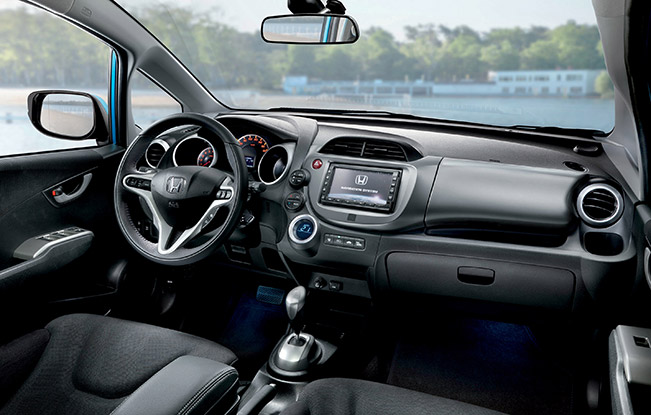
Jazz offers a larger, more relaxing cabin in which seats are designed for greater comfort, all round visibility is significantly better and increased dimensions allow passengers more room to stretch out in a spacious and airy interior. Much of the car's increased length is devoted to improved rear seat comfort and passengers now have 18 mm greater kneeroom and 8 mm more headroom. The distance between front and rear passengers is up by 30mm compared to the previous model which already offered a tandem distance on a par with much larger cars. Shoulder room is up 44mm in the front, 43 mm in the rear.
Honda's design team has placed particular emphasis on improving visibility for the driver. Moving the A-pillar further forward plays a significant part and together with retractable rear seat headrests, the driver has a considerably improved view both front and rear.
Larger glass area
A-pillar width reduced by 23 mm, a windscreen 25 mm wider and 205 mm taller, together with redesigned wipers that sit well below the line of sight, mean forward visibility has been improved by some 20 per cent overall. Furthermore, the front quarter windows are approximately three times the size of those in the previous Jazz and the door mirror mounts are actually reduced in size, even though the mirror surface area is increased by almost a third. Retractable rear seat headrests result in rearward visibility up from 72 to virtually 100 per cent.
Added serenity Even greater refinement means the Jazz's cabin is a pleasant place to be thanks to the greater body rigidity which minimises noise and vibration during idling as well as any booming noise when cruising. Noise from the engine during acceleration and road noise are also reduced considerably thanks to extra use of lightweight sound absorbing materials in the roof, carpet and dashboard.
front seats are fitted with springs and padding optimised for greater comfort and better support and grip during cornering, as well as active headrests for greater safety. A tilt and telescopic steering wheel with a wider range of adjustment, 50 mm driver's seat height adjustment via a ratchet lever, wider pedal spacing and a footrest for the left foot ensure a comfortable position for the vast majority of drivers. Rear seat passengers also benefit from larger seats, now 20 mm wider, 15 mm deeper and with seat cushions 10 mm thicker.
Front seats are heated on 1.4 ES and EX models, while the EX also has front and rear seat armrests.
Jazz's interior is upholstered in two colour combinations: 1.2-litre models are equipped with a blue/black fabric, with blue seat and door trim inserts, while all other 1.4-litre models have a black/dark grey treatment. The fascia is set low for good forward visibility and features a large three meter instrument cluster with central speedometer, a tachometer on the left and a fuel gauge to the right. Permanent back lit illumination ensures good legibility even in low light conditions. Silver meter surrounds are complemented by gun metallic-finish dials with a red acrylic scale raised above the surface to create a 3D effect.
Contained within the centre of the speedometer face is an LCD multi-information display showing a variety of information including a speed alarm, instant and average fuel economy, range, outside temp and a service indicator based on actual driving conditions (tracked by the ECU) - controls positioned on the steering wheel allow the driver to cycle through the displays.
The indicators have a soft touch mode: gently touching the appropriate lever causes that indicator to flash three times before self-cancelling, making lane changes on motorways, for example, effortless.
Audio systems
All models from 1.2 LS and above are equipped with a single CD/audio system with MP3/WMA playback capability. Its stylish face panel seamlessly integrates into the fascia and features a black background LCD and auxiliary jack. Volume automatically adjusts in accordance with vehicle speed. The simple-to-use rotary control is of the push-turn-push type. A rear-mounted micro antenna with automatic gain control can improve sensitivity when radio reception is weak. On 1.4 ES and EX models, the four high quality polypropylene speakers are supplemented with a pair of tweeters, while fifth generation and later iPods and a variety of other digital audio players can now be played via the audio system using the USB adapter located in the centre console storage box. Playback using the main audio controls also provides simultaneous charging of the device (depending on type).
Bluetooth-enabled
The Jazz 1.4 EX is provided with a Bluetooth wireless mobile phone interface, allowing hands-free operation, controlled via a steering wheel-mounted switch. A series of speakers and microphones installed in the car can connect to any Bluetooth-enabled communications device, allowing calls to be made safely while driving. Features include display of the phone number, phone mode and battery status in the multi-information display; continuation of a phone conversation started outside the car, simply by turning on the ignition to ‘ACC' and then switching to hands free; and automatic transfer of numbers which can be accessed with HFT and speech recognition - in English, French, German, Italian or Spanish.
Cabin storage
Jazz comes complete with plenty of handy in-cabin storage able to swallow a large amount of family clutter. Separated into upper and lower compartments and separated by a shallow tray, the two-tier glovebox offers greater versatility. The upper section comes complete with pen and card holders and, on 1.4 ES/EX models, a valve which can be opened to provide a stream of cooling air to chill a bottle or drinks can.
There are no less than 10 cup/bottle holders spread around the cabin - one at either end of the instrument panel, two in the centre console ahead of the gear lever, two behind the handbrake, and one in each of the four door pockets set into the curved door panels. The versatile front console storage can also accommodate a variety of items such as drinks cartons, iPods, mobile phones or a box of tissues. Added flexibility is provided by a subdivider which can be turned through 180 degrees to vary the storage dimensions. To the right of the steering wheel is a fascia pocket.
There is now also a handy compartment in the base of the left hand rear seat, accessible when it is folded upwards. Opened by unscrewing two knurled wheels, it is able to accommodate the owner's manual. The air conditioning - a manual system on the 1.2 LS, and automatic on 1.4 models - offers improved cooling performance with increased air flow, while using less refrigerant and power; the fan is also quieter. The high performance dust filter can be supplemented with an optional high performance deodorant filter.
Air conditioning controls are spaced around the audio system within easy reach of the driver.
1.4 EX panorama roof
For the ultimate in cabin airiness and a real sense of spaciousness, the 1.4 EX model comes with a full length panorama roof. 721 mm wide and 938 mm long, it extends back far enough to give rear seat passengers the same sky view as those in front. Although the glass has high heat absorbing properties, there is also a power sun shade which can be opened and closed at the touch of a switch to create a comfortable cabin environment all year round..
Jazz's acclaimed Magic Seats now even more convenient
One of the most distinctive elements of the previous generation Jazz and a key factor in its popularity was the Magic Seats design acclaimed for its flexibility and multiple seating and cargo-carrying configurations. The Jazz not surprisingly retains the arrangement but is now even more user-friendly. Front seats no longer need to be slid forward to give the rear seat sufficient clearance as it is folded down. Instead, even with the front seats in their rearmost position, the 60:40 split rear seats with their retractable headrests can be collapsed in a simple ‘one-motion' dive-down action by means of a lever located on the outside shoulder of the seat.
In this ‘Utility Mode', Jazz offers a perfectly flat load floor, a maximum 1720 mm in length, sufficient to swallow three 26 inch mountain bikes with front wheels still attached, stood upright. The actual surface area equates to two large and two extra-large Samsonite suitcases laid flat; similarly, three golf bags can be laid lengthwise. With the larger rear seat portion alone collapsed, there is sufficient space and length to accommodate a surfboard laid flat; or two 26 inch mountain bikes stood upright. The available load length is even greater in ‘Long Mode' where the front passenger seat is slid fully forward and its seatback fully reclined - opening up a 2.4 m long load space.
To return the rear seats to a seating position, you simply lift the assembly back up; the seat bottom remains locked to the seat back and is simply released by pulling up the leg frame and the seat bottom folded down.
This locking seat base action adds further innovation and Jazz's unique offer, since in ‘Tall Mode' the seat bases can be left raised and locked against the seat backs, creating a second load area between front and rear seats capable of holding a variety of objects up to 1280 mm in height, such as tall plants, two mountain bikes with their front wheels removed, a folded wheelchair, and all manner of other items. And since the rear doors now open wider, it is even easier to make full use of this feature.
Magic Seats now complemented by Double-Trunk boot
The same levels of innovation are found in the luggage bay of the Jazz which now offers a class-leading capacity that betters some B-segment compact MPVs. Beneath the boot floor lies a secondary storage compartment and on 1.4 models the provision of an emergency tyre repair kit in place of a space-saver spare wheel frees up this space, adding an extra 64 litres to give an exceptional load capacity of 399 litres (VDA) compared to the 380 litres of the previous generation Jazz (9 litres of underfloor storage with space saver wheel).
Double-Trunk boot system is also introduced on 1.4-litre Jazz models with tyre repair kit, giving owners greater convenience and perfectly complementing the Magic Seats arrangement. In ‘Regular Mode', the under floor storage area is concealed by a 100 kg-capacity double hinged panel. This panel can be folded against the rear seats in ‘Tall Mode' to make use of the full depth of the load space enabling particularly tall objects to be carried.
Alternatively, rather than folding the complete panel against the rear seat backs, its rear half can be raised into a horizontal position, and supported by fixtures in the load bay sides, to create a mid-height storage shelf and effectively separating the luggage space into upper and lower sections - the so called ‘Upper/lower Mode'. The net contained within the upper panel is perfect for carrying irregularly shaped objects that won't sit flat.
The 230 mm deep under floor space is ideal for storing sports gear or raincoats and umbrellas and once the lid is on, you don't have to worry about soiling other luggage. A load lip 605 mm from the ground makes for easy loading and unloading. Finally, a useful shopping bag hook is located just inside the left hand side of the luggage bay.
DRIVETRAIN
- i-VTEC 1.2 and 1.4-litre petrol engines
- Lower CO2 emissions, enhanced fuel economy and improved performance
- Tumble inducing intake ports
- Low friction engine design
- Drive-by-wire throttle control
- Standard 5-speed manual transmission
- Latest 6-speed i-SHIFT automated manual transmission with paddle shifters optional on 1.4-litre engine
Honda has set out to provide the Jazz with a best in class balance between fuel economy and fun-to-drive performance. In place of the two-valve i-DSI technology used in the previous Jazz, the latest range is powered by newly-developed four-valve i-VTEC petrol engines of either 1.2-litre or 1.4-litre capacity that deliver lively performance and plentiful torque across all engine speeds.
A capacity of 1198cc makes the 1.2-litre engine slightly smaller than its predecessor yet power rises from 78 to 90 PS at a slightly higher 6000 rpm; similarly torque increases from 110 Nm to 114 Nm at 4900 rpm. 1.4-litre engine shares the same 1339cc swept volume as the previous i-DSI engine but output is up from 83 to 100 PS, again at a slightly higher 6000 rpm. Torque is boosted to 127 Nm at 4800 rpm compared to the i-DSI engine's 119 Nm at 2800 rpm.
i-VTEC
Honda's familiar VTEC variable valve timing system helps to make possible the balance between efficiency and power and employs a two rocker arm design per cylinder on the intake valves. This incorporates friction-reducing roller followers for each pair of intake valves, along with intake cam lobes configured to optimise both low and high speed operation. Depending on engine load and engine speed, an electronic controller determines which cam profile will be used and exactly how the intake valves will operate.
At low revs, where low lift and shorter duration provide optimal operation, the timing of the two intake valves is staggered and the lift asymmetrically skewed in favour of the primary valve. This helps to create a strong swirl effect within the combustion chamber that increases the efficiency of the burn process. At higher rpm, a hydraulically actuated spool valve causes a locking pin to engage the secondary rocker arm with the primary one, transitioning the secondary valve into a long-duration mode that increases the volume of air/fuel mixture moving into the combustion chamber. This additional mixture helps increase power at high engine speeds. The head utilises a narrow, 30-degree design between the intake and exhaust valves, contributing to the overall compact size.
As well as VTEC valve-train technology, other notable features are an improved combustion chamber shape, a drive-by-wire throttle control, a composite intake manifold with a long runner design that contributes to good low and mid-range torque output and friction reducing technologies. These include roller-tipped rocker arms, an offset crankshaft/connecting rod design,lateau honing of the cylinders for a smoother surface, a special piston surface coating which is better at oil retention and optimised piston ring tension. A narrow-width timing chain and tensioner reduce weight.
High-strength ‘fracture split' connecting rods provide a significant reduction in the inertial mass of moving parts for increased efficiency (‘fracture-split' refers to the manufacturing process whereby the connecting rods are forged in one piece and then their crankshaft ends are broken, creating a lighter and stronger rod with a perfectly fitted bearing cap).
The exhaust manifold is cast directly into the alloy cylinder head to reduce weight and allows the optimal positioning of the primary close-coupled catalytic converter; together with exhaust gas recirculation and a high accuracy air/fuel ratio control - comprising intake air flow sensor, linear air flow sensor ahead of the close coupled cat and a rear oxygen sensor ahead of the rear cat - Jazz offers excellent emissions performance.
Electronic drive-by-wire (DBW) throttle control optimises the throttle aperture when the accelerator is depressed for quick and precise delivery of fuel to the engine, so maximising efficiency. The end result is an engine design with good low end torque, high-revving power and a high level of fuel efficiency.
Transmissions 1.2 and 1.4-litre models are equipped with an evolution of the previous 5-speed manual transmission with gear ratios optimised for driveability whilst ensuring good fuel economy. Key improvements include a revised clutch pedal stroke, carbon-type synchroniser on third gear to minimise shift load, crisper shifting through reduced clutch disc inertia and improved refinement.
Manual transmission-equipped models feature the SIL (Shift Indicator Light) within the centre of the rev counter, also found on the latest Honda Accord. Providing the driver with a visual prompt of the best gear shift points to maximise economy, it has been demonstrated to provide meaningful fuel economy savings.
i-SHIFT (6-speed automated manual transmission)
As well as a 5-speed manual gearbox, the 1.4-litre engine can be teamed up with Honda's latest i-SHIFT transmission, first introduced in the Civic range. The 6-speed automated manual transmission in this vehicle offers better fuel economy than is possible with either a conventional automatic or a CVT (continuously variable transmission). The unit is a development of the system first fitted to the Civic, with improvements made including; reduced gear change times, smoother shifts and more intelligent automatic mode shift logic.
The driver can choose between either an Auto Mode for a more relaxed driving style, or for a sportier driving experience, Manual Mode via the gearshift or steering wheel mounted paddles - that on the left controlling downshifts, that on the right upshifts.
Automatic Mode is selected by moving the gearshift to the left of the main gate, while sequential changes in Manual Mode are made by moving the lever either forwards (up changes) or backwards (down changes) in the main gate or by using the paddles.
The shift lever requires only a short - 13.5 mm - movement to select the next gear so emulating a sporty driving feel. Furthermore, reverse is in the conventional manual transmission position, thus permitting selection without requiring a visual check from the driver.
The conventional clutch pedal is replaced by a Transmission Control Unit that controls the clutch via an actuator with hydraulic power generated by a DC motor; gear changes are smooth and quick as a result, without compromising the system's sportiness.
It is perfectly possible to override automatic mode momentarily, by switching to paddle operation - so for example the driver can change down a couple of gears for added acceleration.. The selected gear in both automatic and manual modes is shown in a display located within the fuel gauge dial, with the letter ‘A' supplementing the gear number when automatic is selected.
The i-SHIFT gearbox is designed to adapt to different driving conditions by means of a series of shift maps. For example, when driving downhill, the system will shift down to provide engine braking. Similarly, shifting is prevented through a corner if there is any possibility of upsetting the car's balance.
Other safeguards mean that at low rpm the system will not shift up, even if instructed to do so, thus preventing malfunction and engine knocking. And there is an automatic upshift just before the red line in order to avoid damaging the engine by over revving. When the car stops in fourth gear, the system will automatically shift back to first in both modes.
After starting the engine with the lever in neutral, the system defaults to automatic mode. When manual mode is selected, the driver may opt to start in 2nd gear. In-gear parking is also possible by turning the engine off when the shift indicator shows either first gear or reverse.
i-SHIFT models are also equipped with Hill Start Assist (HSA). When pulling away from standstill on an incline, HSA continues to apply the brakes for a couple of seconds as the driver moves his or her foot from the brake pedal to the accelerator, thus preventing roll back.
CHASSIS
- Greater agility, improved ride comfort
- Longer wheelbase, wider track and 15 inch or 16 inch wheels
- Modified front MacPherson strut and rear torsion beam suspension
- Revised geometry and uprated EPS components improve steering feel and stability
- Uprated brakes
- VSA available on all models
- Turning circle unchanged for excellent manoeuvrability
Together with the more powerful engines, greater in cabin refinement and a series of suspension revisions, Jazz offers greater agility and pleasant, more comfortable driving dynamics. Higher body rigidity ensures a more responsive, and at the same time more supple, suspension.
Key improvements include the increased wheelbase and wider track for greater stability, larger wheels, improved steering feel and a suspension that retains the same basic layout but benefits from a number of changes in layout and geometry. And despite the slightly increased dimensions, the turning circle kerb to kerb is identical to the previous Jazz at a tight 9.8m, ensuring superb manoeuvrability about town.
Geometry revisions
The front MacPherson struts feature optimised geometry and a revised lower suspension arm bushing which rather than working in a vertical direction - as in the previous Jazz - requiring it to be very rigid to resist vertical movement, is now located longitudinally. Lower arm input twists the bush axis for more stable suspension characteristics, allowing the bush to have a lower spring rate.
Front wheel caster angle has been increased from 2.2 to 3.3 degrees and the caster trail from 5 to 20 mm which has the effect of boosting straight line stability. Jazz's rear suspension continues to use a compact H-shaped torsion beam which means the load floor can be kept low with a resulting increase in luggage capacity.
The ‘H' section has been revised, however, while other changes include a 39 mm longer trailing arm, a trailing arm bush capacity increased by almost 50 per cent and, by moving the spring and damper assemblies further back relative to the wheel, a spring lever ratio changed from 1.5 to 1.1. Those changes translate on the road to a much smoother, more comfortable ride.
Rear roll steer characteristics have also been improved for increased stability during cornering. Over the total rear wheel movement, the degree of camber change and the amount of toe in under compression and toe out on rebound are all increased.
Vehicle Stability Assist
All Jazz models can be equipped with Honda's Vehicle Stability Assist (VSA) system which is designed to assist the driver in maintaining control during cornering, acceleration and sudden manoeuvres by applying braking independently on all four wheels as necessary and managing the engine torque systems.
At its simplest level, VSA has a traction control function whereby it detects wheel slip under acceleration and coordinates the use of braking and engine torque to regain traction. In situations where the driven wheels are on surfaces with different levels of traction, such as a partially wet road surface, the system applies braking action to the wheel that's slipping, allowing the tyre with better grip to move the vehicle. In addition, the system reduces engine output to minimise wheelspin.
By monitoring input from a series of vehicle sensors, VSA calculates a predicted range of vehicle response while constantly monitoring the vehicle's actual response and the driver's control inputs. If the actual response is outside the predicted response range, as when cornering forces exceed the tyres' performance, VSA automatically intervenes with corrective action.
In the case of oversteer (which may lead to a spin), VSA applies braking to the outside wheel to counter the yawing tendency. On the other hand, if understeer is detected, VSA applies braking to the inside wheel and reduces engine power to turn the car back on to the intended course.
An indicator light flashes on the instrument panel while the system is actively enhancing the stability of the vehicle. A cockpit switch to the side of the instrument panel is provided to disable the VSA.
More communicative steering
Jazz continues to use electric power steering, but in the latest model the system has been completely revised and feedback and stability have been considerably enhanced for a more direct steering feel and a more enjoyable driving experience.
Both the rigidity of the steering gearbox and its installation have been increased and together with a motor capacity increased from 40 to 60 A and the revised suspension geometry described above, the result is a light steering feel at low speeds and good stability at high speeds with improved on centre feel.
Uprated brakes
The braking system comprises ventilated discs at the front and discs at the rear and all Jazz models are equipped with an ABS system with electronic brake force distribution and brake assist functionality as standard equipment. Greater stopping power comes courtesy of larger front brake callipers, while brake pedal feel has been optimised and now requires less driver effort to achieve the same effect.
1.2 S and LS, and 1.4 LS models are equipped with 15 inch steel wheels fitted with twin 5-spoke trims and shod with 175/65 R15 tyres. Jazz 1.4 ES gains 5-spoke alloy wheels of the same size, while the 1.4 EX model has a choice of 15 inch or 16 inch twin 5-spoke alloys .
APPENDIX I - ACCESSORIES Exterior accessories Chrome pack
This includes a chrome front grille, door handle covers and a tailgate decoration, allowing the owner to add extra style to the car.
15" & 16" Alloy Wheels
Specially designed 15" Crystal and 16" Cronos alloy wheels are available for Jazz. The Crystal alloys come with a clear coat finish and black pearl window, while the Crono alloys come with a full colour chrome shadow coat finish. All Honda wheels have passed extensive testing in the research as well as the development stage and match European car homologation.
Front, Rear & Side Body Trims
Made of soft material and with a flexible paint finish, these trims will protect the bodywork from any annoying scrapes and scratches that can be collected in city traffic. The trims are available in the car's body colour.
Tailgate spoiler
This lightweight, aerodynamic spoiler adds to the design of Jazz and gives it an extra-vivid, sporty profile. It extends the car's bodywork and perfectly follows the contours of the car. The tailgate spoiler is available in the car's body colour.
Interior accessories Child seat safety
As from this year, a KIDFIX version of the largest child seat (Group 2&3) will be available which can be secured in the car using ISOFIX anchors, providing quick, easy and proven security for children up to twelve years old.
Interior decoration panels
Available in two different versions, the interior decoration panels are heat-, chemical- and UV-resistant, and are specially designed to eliminate light reflection.
Audio & Electronics
Parking sensors
Integrated into the front and rear bumpers, a set of parking sensors protect the car and enable manoeuvres into the smallest of parking spaces.
Honda Compact Navigation System
The newly developed widescreen portable navigation system is also designed to complement the car's interior. Its attachment fits perfectly to the dashboard; no more suction cups falling down and almost no wiring on show. It includes full European mapping, and the latest European Points-of-Interest including a complete list of Honda car & motorcycle dealers. In addition, it comes with an integrated TMC antenna for up-to-date traffic information. The unique anti-glare back reduces distracting windscreen reflections. Extra features include Bluetooth wireless technology, WMA/MP3 function, JPEG viewer & audio book player.
Rear Entertainment System
Portable Rear Entertainment System is perfectly in style with the Jazz's interior and is installed in the back of the front seat(s), allowing a proper functioning of the active headrests. It offers the option of adding a second monitor on the passenger side. A compact remote control is included & wireless headphones are available in two sizes.
Honda Hard Disk Drive Navigation
The Honda HDD Navigation System sets a benchmark in touch screen in-car navigation and entertainment. It features a 30 GB Hard Disk Drive to pack a host of navigation functions, and boasts powerful image and sound capabilities. Its high-performance navigation engine processes and displays the map data in a flash. Or turn your system into your private jukebox by using the Music Catcher to store your favourite tunes in the unit's memory. The HDD Navigation System also offers 2-Zone capabilities and is compatible with Bluetooth®-enabled mobile phones. Optionally, it comes with iPod direct connection and control, allowing you to control your iPod directly from the system's 7-inch QVGA touch panel. You can also add a rear view camera to see what's behind your car when in reverse.
Bluetooth® Phone System
The Bluetooth® Phone System is a simple, safe and convenient hands-free solution, which allows the driver to easily manage calls while keeping focused on the road.
JAZZ TECHNICAL SPECIFICATIONS
| ENGINE | 1.2 SOHC i-VTEC | 1.4 SOHC i-VTEC | 1.4 i-SHIFT SOHC i-VTEC | |
| 4 valves per cylinder | ||||
| Bore x stroke | mm | 73 x 71.6 | 73 x 80 | 73 x 80 |
| Capacity | cc | 1198 | 1339 | 1339 |
| Compression ratio | 10.8 | 10.5 | 10.5 | |
| Max. power | kW/PS | 66/90 | 73/100 | 73/100 |
| @ rpm | 6000 | 6000 | 6000 | |
| Max. torque | Nm | 114 | 127 | 127 |
| @ rpm | 4900 | 4800 | 4800 | |
| Fuel system | Honda PGM-FI Electronic Injection | |||
| Fuel rating | Unleaded, 95 RON | |||
| ELECTRICAL | ||||
| Battery | 12V 28Ah | |||
| Alternator | 35A | |||
| DRIVETRAIN | ||||
| Front-wheel drive | 5-speed manual gearbox | 5-speed manual gearbox | 6-speed automated manual gearbox | |
| Clutch | Single plate, diaphragm spring | |||
| Gear ratios | 1st | 3.307 | 3.307 | 3.461 |
| 2nd | 1.750 | 1.750 | 1.869 | |
| 3rd | 1.171 | 1.235 | 1.235 | |
| 4th | 0.853 | 0.948 | 0.948 | |
| 5th | 0.727 | 0.809 | 0.809 | |
| 6th | - | - | 0.727 | |
| Reverse | 3.307 | 3.307 | 3.307 | |
| Final | 4.625 | 4.294 | 4.294 | |
| SUSPENSION | ||||
| Front | MacPherson struts and stabiliser bar | |||
| Rear | Trailing arm with torsion beam and stabiliser bar | |||
| STEERING | ||||
| Type | Rack and pinion, electrical power assisted | |||
| Turns lock to lock | 3.42 | 3.29 /3.42* | 3.29 / 3.42* | |
| TURNING CIRCLE | ||||
| At wheels | 9.8 (9.4 depending on grade*) | |||
| Wall to wall | 10.4 (10.1 depending on grade*) | |||
| BRAKES | ||||
| Front | Ventilated discs | |||
| Rear | Discs | |||
| DIMENSIONS, WEIGHTS, CAPACITIES | ||||
| Overall length | mm | 3900 | ||
| Overall width | mm | 1695 | 1695 | 1695 |
| Overall height | mm | 1525 | ||
| Wheelbase | mm | 2500 | ||
| Ground clearance | mm | 150 | ||
| Luggage space | litre | 399 | ||
| Kerb weight | kg | 1047 | 1073 | 1082 |
| Max. permitted weight | kg | 1500 | 1500 | 1540 |
| Fuel tank capacity | litres | 42 | ||
| CONSUMPTION (1999/100/EC) | ||||
| Urban | l/100km | TBA | TBA | TBA |
| Extra Urban | l/100km | TBA | TBA | TBA |
| Combined | l/100km | TBA | TBA | TBA |
| CO2 emissions | g/km | TBA | TBA | TBA |
| PERFORMANCE | ||||
| Top Speed | km/h | 177 | 182 | 180 |
| Acceleration 0-100km/h | 12,6 | 11,4 – 11,6 | 13,6 | |
In-house data * Depending on grade and wheel size fitted


